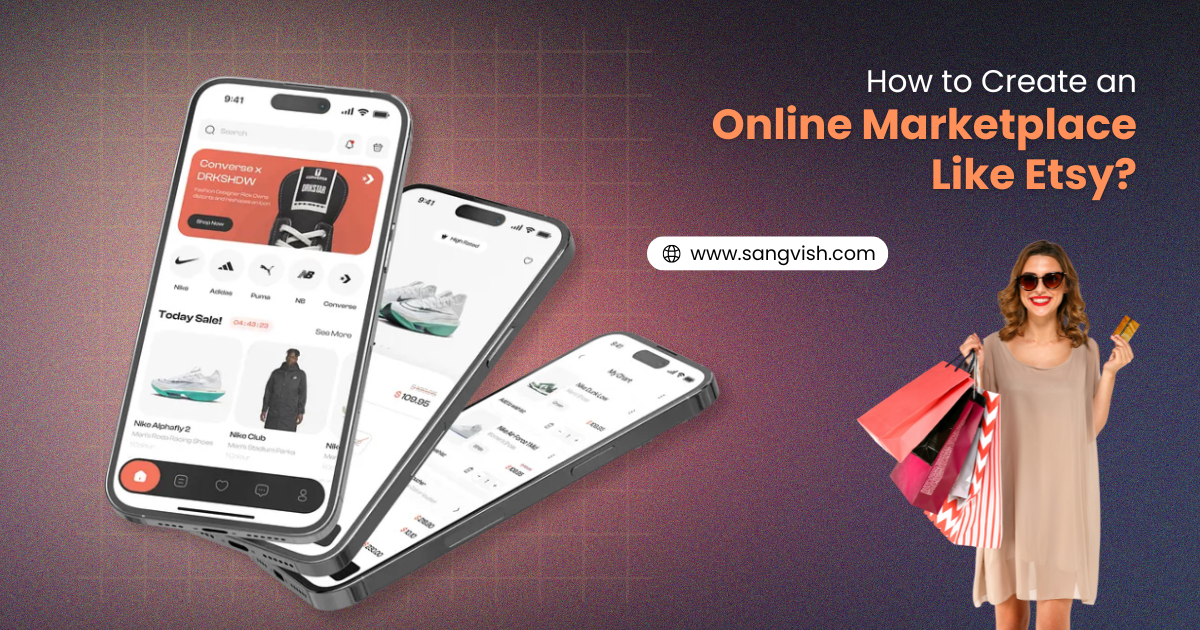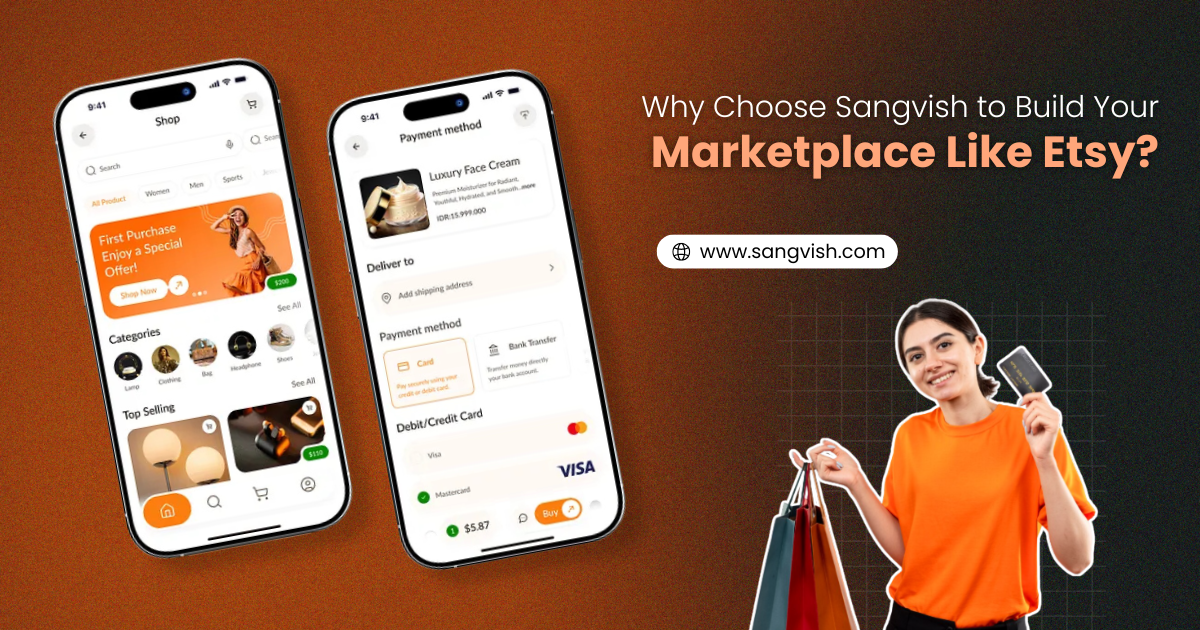In the new digital era, crafts and crafts, antiques, and artistic works have a new appearance in the online environment.
Markets such as Etsy have transformed the manner in which producers and small entrepreneurs connect with their clients all over the world. You are not alone if you have ever considered starting your own online marketplace, such as Etsy.
The establishment of an eCommerce platform, such as Etsy, can create an opportunity for a community-based platform where art can intersect with business.
Determining your specialty, selecting a technological platform, and developing a website with necessary features like vendor registration, product listings, a secure payment gateway, and a review system are all necessary steps in starting an online marketplace like Etsy.
You can utilize a specialized multi-vendor e-commerce builder like Etsy or start from scratch with custom code.
We will step-by-step through all that you should know in this guide: planning and virtually launching your marketplace.
🌟 What Is an Online Marketplace Like Etsy?
An online marketplace like Etsy is a multi-vendor ecommerce platform that links a variety of merchants and buyers, with transactions managed centrally.
These online platforms, often known as electronic marketplaces, are popular for niche commodities such as handcrafted goods, vintage products, and craft supplies, but they can also offer a broader range of goods depending on the platform.
Unlike traditional online stores that sell only one brand’s products, marketplaces host multiple independent sellers under one roof.
What is an Etsy Clone?
An Etsy clone is a ready-made e-commerce software solution that replicates the fundamental characteristics of the Etsy marketplace, allowing businesses to build their own online platforms for buying and selling handmade, antique, and unique goods.
🧭 Step-by-Step Guide to Creating a Marketplace Like Etsy
We want to break down the steps of creating your own eCommerce marketplace, similar to Etsy, from concept to launch.
Step 1: Define Your Niche and Target Audience 🎯
You must also make a decision as to the nature of goods that your platform would sell before leaping into development.
Ask yourself:
✅ Who is going to sell in your marketplace?
✅ What type of purchasers would you like to attract?
✅ What is unique about your platform as compared to Etsy?
Niching also enables you to get the right sellers and clients and minimize competition.
▪️ Market Research: Find a niche, get to know your target audience, and study your competitors.
Step 2: Plan Your Revenue Model 💰
▪️ Business Model: Determine how to charge, whether via a percentage on sales, like the one used by Etsy.
▪️ MVP Development: Use a Minimum Viable Product (MVP) to validate your idea and collect feedback before launching full scale.
What will be your platform monetizer?
The following are some of the most popular ones:
▪️ Commission model: Pay a percentage of every sale (as in Etsy).
▪️ Subscription model: impose a subscription fee on the sellers of the products.
▪️ Listing fee model: Sellers are charged a product listing fee.
▪️ Advertising: Have sponsored ads or product placements.
Step 3: Choose the Right Technology Stack ⚙️
The nature of your technology will decide the extent of scalability and efficiency of your marketplace.
When you are not a programmer, a pre-built solution from a marketplace could save time and money.
Popular options include:
▪️ Custom development: Custom build your marketplace (flexible and expensive).
▪️ Clone scripts: Etsy Clone Script ( clone ) – a script that can be entirely customized and deployed in a relatively short time.
🧩 Pro Tip:
Sangvish is a marketplace script that can be tailored to fit your vision, like Etsy and assist you in launching your platform without extensive technical expertise.
Step 4: Design a User-Friendly Interface 🎨
Intuitive and clean interface keeps the users interested.
Must-have design elements:
📌 Simple navigation 🧭
📌 High-quality product images 📸
📌 Mobile responsiveness 📱
📌 Easy registration & checkout 🔑
📌 Categorization 🗂️
Browsing must be fun and purchases easy through your design.
Step 5: Implement Essential Features 🧰
Both buyers and sellers on your eCommerce marketplace such as Etsy, should have fundamental functionality.
🛍️ Buyer Features:
▪️ Product search and filters
▪️ Secure checkout process
▪️ Wishlist and favorites
▪️ Order tracking
▪️ Ratings and reviews
🧵 Seller Features:
▪️ Vendor dashboard
▪️ Inventory control and uploading of products.
▪️ Sales analytics
▪️ Payment tracking
▪️ Messaging with customers
⚙️ Admin Features:
▪️ Manage users and listings
▪️ Payment management
▪️ Commission settings
▪️ Dispute resolution
▪️ Analytics and reporting
The presence of these features makes the operations of all people flawless.
Step 6: Integrate Secure Payment Gateways 💳
Everything in an online marketplace is trust. Make sure your platform accepts more than one secure payment method, such as:
▪️ PayPal
▪️ Stripe
▪️ Credit/Debit cards
▪️ Wallet or escrow options
Step 7: Build Trust with a Strong Community 🤝
The business, such as Etsy, is built around community. Encourage engagement by:
▪️ Permitting reviews and ratings.
▪️ Development of seller profiles using narratives.
▪️ Offering customer support
▪️ Development of a blog or newsletter with the best creators.
A credible community leaves users coming over and tells by word of mouth.
Step 8: Optimize for SEO and Marketing 📈
Visibility is of the essence regardless of the size of your platform.
🔍 SEO Best Practices:
▪️ Apply descriptive titles and meta tags.
▪️ Minimize product image (alt text + compression).
▪️ Enable user-friendly URLs.
▪️ Create a blog with niche keywords (e.g., eco-friendly handmade crafts).
📢 Marketing Channels:
▪️ Social media (Instagram, Pinterest, TikTok to be pictorial).
▪️ Email newsletters.
▪️ Paid ads (Google Ads, Meta Ads).
▪️ Influencer partnerships.
Step 9: Test and Launch 🚀
Test everything before going live!
✅ Check for:
▪️ Page load speed
▪️ Mobile responsiveness
▪️ Checkout functionality
▪️ Integration of the payment gateway.
▪️ Error handling and security
Only then, when you are sure that there is a pleasant user experience, launch your platform.
Step 10: Monitor and Scale Your Marketplace 📊
After launch, use user behavior to optimize your platform.
Use tools like:
▪️ Google Analytics (user analytics)
▪️ Hotjar (for heatmaps)
▪️ CRM systems (to retain the users)
With the increase in your marketplace, you might want to include such features as:
▪️ Multi-language support
▪️ Seller promotions
▪️ Referral programs
🔑 What are the Key Benefits of Building an eCommerce Marketplace Like Etsy?
The advantages of developing an e-commerce marketplace platform, such as Etsy, are multiple sources of income, worldwide presence, and the possibility to scale thanks to a model with minimal inventory and a multi-vendor system.
It offers a unified shopping venue to numerous vendors, minimizing their operation expenses and marketing efforts, and developing an extensive product portfolio for customers.
For the Marketplace Owner
🔹 Sustainable and scalable business model: The model does not have the overhead of conventional retail because it is an intermediary, which can expand significantly without a corresponding increase in expenses.
🔹 Multiple sources of revenue: Earn money in a number of ways, such as commissions on sales, seller subscription fees, and advertisements.
🔹 Reach more customers: Link the global community of sellers with global buyers.
🔹 Lower operational expenses: Does not incur the complexities and expenses of inventory and fulfillment, and logistics, since this is done by the sellers themselves.
🔹 Reduced marketing expenses: Take advantage of marketing synergy by all the sellers on the site.
For sellers
🔹 Availability of a vast customer base: Reach a high number of potential customers within a short time who are interested in a particular type of product.
🔹 Less overhead: You do not need to deal with as complicated an infrastructure as you would with a separate online store to create and sell products.
🔹 Growth in revenue possibilities: Grow their business faster and boost sales using the traffic of the platform.
🔹 Customization and flexibility: A variety of platforms will enable the sellers to tailor the look of their shop to form a distinctive brand image.
For buyers
🔹 Various product lines: Discover an assortment of unique, handmade, and vintage products under one roof.
🔹 In-user experience: Get a simple navigation experience, search, and filter range.
🔹 Promoting small businesses: Shop for unique items, and you will be helping artisans and small business owners.
🧩 Why Choose Sangvish to Build Your Marketplace Like Etsy?
We are the Sangvish, and we are the developers of eCommerce marketplace scripts, which enable you, as an entrepreneur, to start a platform in a short time.
🔹 Highlights of Our Marketplace Script:
▪️ 100% customizable design
▪️ Secure payment integration
▪️ Multi-vendor support
▪️ Admin control dashboard
▪️ SEO-optimized structure
▪️ Scalable and affordable solution.
🏁 Conclusion
The establishment of an online marketplace such as Etsy is a profitable endeavor to any business person who would like to unite creators and consumers fruitfully. To ensure usability, trust, and intelligent monetization, you would be able to develop a sustainable and profitable eCommerce business.
It could be a blank sheet or an off-the-shelf solution, but the trick here is that you have to select the right platform that will suit your business objectives.
Start today and create your own eCommerce marketplace similar to Etsy with ease!





